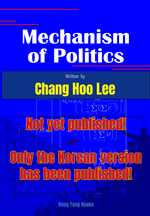| |
Chapter 0. Contents of this
book
(2) Facts about Ideology versus Ideology
as Value

There are many people who believe
that there are significant limitations in explaining
political phenomenon scientifically. The basis of
this argument is that the behavior of people who make
up political phenomenon is greatly influenced by their
mental values and beliefs (which we will call "ideology"),
and these mental factors cannot be explained as causal
relationships of events.
In the 14th century Joseon, where Buddhism criticisms
such as "Bulsijapbyeon (????)" already mentioned,
suppressed the political participation of Buddhist
monks and allowed the blooming of Confucian political
ideologies. Or, the United States of American that
was created by scraping the foundation with democratic
ideals, and Lenin who dominated the government and
built the Soviet Union with the Communist ideal, can
also be examples. Buddhism criticism, Confucianism,
or democratic and communist ideologies are all mental
entities, ideals, and are outside the laws of the
actual causal relationship. Instead, logic and evidence,
sometimes dogmatism, play a more important role. Nevertheless,
these mental things also strongly influence political
phenomena. Then, it may seem impossible for the scientific
approach that focuses on the causal relationship of
events to fully and consistently explain this part.
At first glance, this argument appears
to be correct. However, it stems from confusion that
fails to clearly distinguish the two aspects of ideology.
In other words, if one were to clearly distinguish
the two aspects of ideology, it would be possible
to explain the political phenomenon using a scientific
approach to a significant degree. The distinction
lies between the "facts about ideology"
and "ideology as a value."
The Confucian scholars in Joseon, the United States,
or Soviet Union all be captured in terms of the fact
that they have been assisted in acquiring political
power by their shared ideology. Their ideologies are
composed of very different content, but this is not
a political fact, it is a philosophical fact, so it
can be excluded from important variables in political
causal relationships. One ideology can help with acquiring
power while another may not, and the same ideology
can also have different political effects depending
on the situation. Confucianism in the 14th century
Joseon empowered scholars, but it is not the case
in 21st century South Korea, and even less so in the
United States. Although the content of Confucianism
is the same, its political effect is different.
Therefore, it is possible to find
the characteristics of ideologies that aid in acquiring
power and to explore the causal relationship between
them and their political effects. Additionally, we
can generalize the differences and relationships between
political effects based on the content of the ideologies.
If the characteristic of 14th century scholasticism
is referred to as a "value system that meets
the demands of the masses", then it is a factual
issue as to which ideology has such a characteristic,
and at the same time, a fact common to the ideals
of liberalism during the American independence period
and communism during the Lenin era in Russia. And
this same fact triggers the same causal relationship
of acquiring power.
I mean, if one aims to gain a scientific
understanding of political phenomena, it is important
to not only grasp the important ideologies in a philosophical
manner but also to understand them from a strictly
factual, scientific perspective. In political reality,
this factual aspect of ideology leads to political
effects, and there are many parts where one can comprehend
its causal relationship. Here, the factual aspect
of ideology is referred to as "ideology as a
fact" and the philosophical aspect as "ideology
as a value." This attempt will be carried out
throughout the book.
  
|